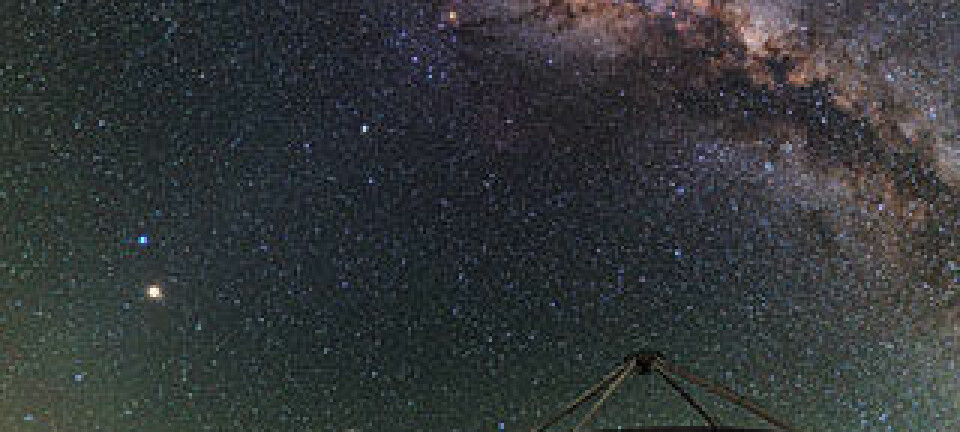
Dark matter: how can we know if it exists?
There may be a whole invisible galaxy in the middle of the Milky Way, with dark suns and planets, and maybe even dark life.
Physicists are more and more certain that the galaxy is full of invisible, dark matter, made of many different particles that interact with each other with unknown forces.
Some physicists go so far as to say that there may be an invisible galaxy made of dark matter, with suns, planets and intelligent, but dark, life, right in the middle of the Milky Way.
But how can they be so certain that dark matter exists, when it is invisible and nearly impossible to detect?
The galaxies are heavier than they look
The simple answer is that physicists have observed it—or rather, its effect.

The American astronomer Vera Rubin noted as early as the 1970s that galaxies in space do not move the way they should. They spin too fast compared to how heavy they are.
At the speed at which galaxies currently spin, they would have to be much heavier than they are, with much stronger gravity to hold all their stars in place. As it is, given their speed and what they appear to weigh, the stars in these galaxies would spin out into the universe.
But since that doesn’t happen, Rubin reasoned the galaxies must be heavier than they look and must contain much more material than can be measured and observed. In fact, calculations show that the visible material in the galaxies of the universe actually makes up only 20 per cent of the material that must actually exist.
But where is the rest?
Dark matter
Perhaps galaxies are full of a substance that is invisible, but that still has gravity? This, in fact, is what the majority of today's physicists believe. They believe 80 per cent of the fabric of the universe is made of dark matter.
If galaxies are located inside spherical clouds of invisible dark matter, this explains why they can spin as fast as they do without sending all their stars flying off into the universe.
And in recent years, observations have confirmed the existence of dark matter. For example, we can see traces of dark matter because its gravity disturbs the light from visible stars.
Today many scientists believe that the Sun and the Earth and the entire Milky Way are enveloped in cloud of dark matter particles. It’s here—all around us.
WIMPs
Scientists believe that dark matter consists of weakly interacting massive particles. These being physicists, they have taken great pleasure in calling these particles WIMPs.
WIMPs are particles with mass, as the name suggests. That means they are affected by gravity. But otherwise they don’t react very much with the known forces and particles in the universe, such as electromagnetism and atoms. This explains why we don’t notice that we are sitting in a cloud of WIMPs.
Because they do not react with anything else, they can actually fly right through us, the Earth and the Sun. Totally without effort. Essentially, they do not affect us and we do not affect them.
But lately there have been results that suggest that the dark matter is not so uniform and boring as it might seem.
Now physicists wonder if dark matter might be as complex as the visible matter in the universe, capable of forming dark atoms and molecules that can be influenced by unknown forces, much like visible matter is affected by nuclear forces and electromagnetism.
A mirror universe?
If this is the case, “you can imagine a kind of mirror universe that is identical to ours, with stars and planets and even intelligent life,” says Professor Are Raklev at the University of Oslo.
Such a universe could have had forces similar to those we know, like nuclear forces and electromagnetism. The dark stars could emit a form of radiation—dark light, or light that we cannot see or measure in any way.
But the professor says we shouldn’t get too carried away in imaging this dark parallel world.
If indeed dark matter is affected by the same kinds of forces that govern our world, then the clouds of dark matter that envelop us would have had to coalesce into suns and planets, much like what happened with matter in the visible universe.
It may in fact have done that in places in the Milky Way, according to a report by Harvard physicists in 2013. But much remains completely unknown.
Dark matter in Switzerland
Some of these questions about the nature of dark matter are now being explored more deeply, as researchers at CERN in Switzerland attempt to create dark matter in the LHC particle accelerator.
With luck, they may succeed in their efforts as early as this year.
In this case, researchers will probably also be able to say more about what dark matter is—for example if there are composite particles that are similar to our protons.
“I think we'll know a lot more in ten years,” says Raklev.
And in particle physics, ten years is not very long.
“This is an exciting time to be studying dark matter,” he said.
-------------------------------------
Read the Norwegian version of this article at forskning.no


































